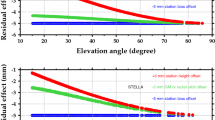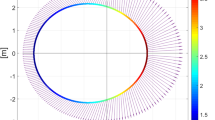Abstract
Although space geodetic observing systems have been advanced recently to such a revolutionary level that low Earth Orbiting (LEO) satellites can now be tracked almost continuously and at the unprecedented high accuracy, none of the three basic methods for mapping the Earth’s gravity field, namely, Kaula linear perturbation, the numerical integration method and the orbit energy-based method, could meet the demand of these challenging data. Some theoretical effort has been made in order to establish comparable mathematical modellings for these measurements, notably by Mayer-Gürr et al. (J Geod 78:462–480, 2005). Although the numerical integration method has been routinely used to produce models of the Earth’s gravity field, for example, from recent satellite gravity missions CHAMP and GRACE, the modelling error of the method increases with the increase of the length of an arc. In order to best exploit the almost continuity and unprecedented high accuracy provided by modern space observing technology for the determination of the Earth’s gravity field, we propose using measured orbits as approximate values and derive the corresponding coordinate and velocity perturbations. The perturbations derived are quasi-linear, linear and of second-order approximation. Unlike conventional perturbation techniques which are only valid in the vicinity of reference mean values, our coordinate and velocity perturbations are mathematically valid uniformly through a whole orbital arc of any length. In particular, the derived coordinate and velocity perturbations are free of singularity due to the critical inclination and resonance inherent in the solution of artificial satellite motion by using various types of orbital elements. We then transform the coordinate and velocity perturbations into those of the six Keplerian orbital elements. For completeness, we also briefly outline how to use the derived coordinate and velocity perturbations to establish observation equations of space geodetic measurements for the determination of geopotential.
Similar content being viewed by others
References
Bender, P.L., Hall, J.L., Ye, J., Klipstein, W.M.: Satellite-satellite laser links for future gravity missions. Space Sci. Rev. 108, 377–384 (2003)
Breiter, S., Elipe, A.: Critical inclination in the main problem of a massive satellite. Celest. Mech. Dyn. Astron. 95, 287–297 (2006)
Brouwer, D.: Integration of the equations of general planetary theory in rectangular coordinates. Astron. J. 51, 37–43 (1944)
Brouwer, D.: Solution of the problem of artificial satellite theory without drag. Astron. J. 64, 378–397 (1959)
Brouwer, D., Clemence, G.M.: Methods of Celestial Mechanics. Academic Press, New York (1961)
Brumberg, V.A.: Perturbation theory in rectangular coordinates. Celest. Mech. 18, 319–336 (1978)
Casotto, S.: Position and velocity perturbations in the orbital frame in terms of classical element perturbations. Celest. Mech. Dyn. Astron. 55, 209–221 (1993)
Cheng, M.K.: Gravitational perturbation theory for intersatellite tracking. J. Geod. 76, 169–185 (2002)
Coffey, S.L., Deprit, A., Miller, B.R.: The critical inclination in artificial satellite theory. Celest. Mech. 39, 365–406 (1986)
Cook, A.H.: The contribution of observations of satellites to the determination of the Earth’s gravitational potential. Space Sci. Rev. 2, 355–437 (1963)
Cui, Ch., Lelgemann, D.: On non-linear low-low SST observation equations for the determination of the geopotential based on an analytical solution. J. Geod. 74, 431–440 (2000)
de Boor, C.: A Practical Guide to Splines. Springer, Berlin (2001)
Deleflie, F., Métris, G., Exertier, P.: An analytical solution of the Lagrange equations valid also for very low eccentricities: influence of a central potentia. Celest. Mech. Dyn. Astron. 94, 105–134 (2006)
De Saedeleer, B.: Analytical theory of a lunar artificial satellite with third body perturbations. Celest. Mech. Dyn. Astron. 95, 407–423 (2006)
Douglas, B.C., Goad, C.C., Morrison, F.F.: Determination of the geopotential from satellite-to-satellite tracking data. J. Geophys. Res. B85, 5471–5480 (1980)
ESA: Gravity field and steady-state ocean circulation explorer mission working group. ESA Publication Division (1996)
ESA SP-1233(1): Gravity field and steady-state ocean circulation mission. ESA Reports for Mission Selection (1999)
Fengler, M.J., Freeden, W., Michel, V.: The Kaiserslautern multiscale geopotential model SWITCH-03 from orbit perturbations of the satellite CHAMP and its comparison to the models EGM96, UCPH2002_02_0.5, EIGEN-1s and EIGEN-2. Geophys. J. Int. 157, 499–514 (2004)
Gooding, R.H.: Complete second-order satellite perturbations due to J 2 and J 3, compactly expressed in spherical-polar coordinates. Acta Astronaut. 10, 309–317 (1983)
Groves, G.V.: Motion of a satellite in the Earth’s gravitational field. Proc. Roy. Soc. Lond. A254, 48–65 (1960)
Guier, W.H.: Determination of the non-zonal harmonics of the geopotential from satellite Doppler data. Nature 200, 124–125 (1963)
Hackbusch, W.: Integral Equations – Theory and Numerical Treatment. Birkhäuser, Berlin (1995)
Han, S.-C.: Efficient determination of global gravity field from satellite-to-satellite tracking mission. Celest. Mech. Dyn. Astron. 88, 69–102 (2004)
Heiskanen, W.A., Moritz, H.: Physical Geodesy. W.H. Freeman Publ. Co., San Francisco (1967)
Ilk, K.H.: Ein Beitrag zur Dynamik ausgedehnter Körper—Gravitationswechselwirkung. Deutsche Geodätische Kommission, C288, München (1983)
Ilk, K.H.: On the regional mapping of gravitation with two satellites. In: Proc. I Hotine-Marussi Symp. Math. Geod., pp. 807–831 (1986)
Ilk, K.H., Feuchtinger, M., Mayer-Gürr, T.: Gravity field recovery and validation by analysis of short arcs of a satellite-to-satellite tracking experiment as CHAMP and GRACE. In: , (eds) A Window on the Future of Geodesy, pp. 189–194. Springer, Berlin (2005)
Ilk, K.H., Löcher, A., Mayer-Gürr, T.: Do we need new gravity field recovery techniques for the new gravity field satellites?. In: Xu, P.L., Liu, J.N., Dermanis, A.(eds) VI Hotine-Marussi Symp. Theor. Comput. Geodesy., pp. 3–8. Springer, Berlin (2008)
Izsak, I.G.: Tesseral harmonics in the geopotential. Nature 199, 137–139 (1963)
Jekeli, C.: The determination of gravitational potential differences from satellite-to-satellite tracking. Celest. Mech. Dyn. Astron. 75, 85–101 (1999)
Jekeli, C., Upadhyay, T.N.: Gravity estimation from STAGE, a satellite-to-satellite tracking mission. J. geophys. Res. B95, 10973–10985 (1990)
Jupp, A.H.: The critical inclination problem – 30 years of progress. Celest. Mech. 43, 127–138 (1988)
Kaula, W.M.: Analysis of gravitational and geometric aspects of geodetic utilization of satellites. Geophys. J. R. Astr. Soc. 5, 104–133 (1961a)
Kaula, W.M.: A geoid and world geodetic system based on a combination of gravimetric, astrogeodetic and satellite data. J. Geophys. Res. B66, 1799–1811 (1961b)
Kaula, W.M.: Theory of Satellite Geodesy. Blaisdell Publishing Company, London (1966)
Kim, J.: Simulation study of a low-low satellite-to-satellite tracking missions. PhD Dissertation, The University of Texas at Austin (2000)
Kondo, J.: Integral Equations. Clarendon Press, Oxford (1991)
Koop, R.: Global gravity field modelling using satellite gravity gradiometry. Netherlands Geodetic Commission, Publ. Geod. New Series No. 38, Delft (1993)
Kozai, Y.: The motion of a close Earth satellite. Astron. J. 64, 367–377 (1959)
Kozai, Y.: Second-order solution of artificial satellite theory without air drag. Astron. J. 67, 446–461 (1962)
Kozai, Y.: The Earth gravitational potential derived from satellite motion. Space Sci. Rev. 5, 818–879 (1966)
Kudryavtsev, S.M.: The fifth-order analytical solution of the equations of motion of a satellite in orbit around a non-spherical planet. Celest. Mech. Dyn. Astron. 61, 207–215 (1995)
Liu, X.-L., Ditmar, P.: Smoothing a satellite orbit on the basis of B-spline and regularization. Chinese J. Geophys. 49, 86–94 (2006)
Mayer-Gürr, T., Ilk, K.H., Eicker, A., Feuchtinger, M.: ITG-CHAMP01: a CHAMP gravity field model from short kinematic arcs over a one-year observation period. J. Geod. 78, 462–480 (2005)
Merson, R.H., King-Hele, D.G.: Use of artificial satellites to explore the Earth’s gravitational field: Results from SPUTNIK 2 (1957β). Nature 182, 640–641 (1958)
Peláez, J., Hedo, J.M., Rodríguezde Andrés, P.: A special perturbation method in orbital dynamics. Celest. Mech. Dyn. Astron. 97, 131–150 (2007)
Prussing, J.E., Conway, B.A.: Orbital Mechanics. Oxford University Press, Oxford (1993)
Reigber, C., Balmino, G., Schwintzer, P., Biancale, R., Bode, A., Lemoine, J.-M., König, R., Loyer, S., Neumayer, K.-H., Marty, J.-C., Barthelmes, F., Perosanz, F., Zhu, S.Y.: Global gravity field recovery using solely GPS tracking and accelerometer data from CHAMP. Space Sci. Rev. 108, 55–66 (2003)
Reubelt, T., Austen, G., Grafarend, E.: Harmonic analysis of the Earth’s gravitational field by means of semi-continuous ephemerides of a low Earth orbiting GPS-tracked satellite. Case study: CHAMP. J. Geod. 77, 257–278 (2003)
Rosborough, G.W., Tapley, B.D.: Radial, transverse and normal satellite position perturbations due to the geopotential. Celest. Mech. 40, 409–421 (1987)
Rowlands, D.D., Ray, R.D., Chinn, D.S., Lemoine, F.G.: Short-arc analysis of intersatellite tracking data in a gravity mapping mission. J. Geod. 76, 307–316 (2002)
Rummel, R.: Geoid and gravity in Earth sciences – an overview. Earth Moon Planet 94, 3–11 (2004)
Rummel, R., Balmino, G., Johannessen, J., Visser, P., Woodworth, P.: Dedicated gravity field missions – principles and aims. J. Geodyn. 33, 3–20 (2002)
Schneider, M.: A general method of orbit determination, Report 1279. Royal Aircraft Establishment, Hants, UK (1968)
Schneider, M.: Observation equations based on expansions into eigenfunctions. Manuscr. Geod. 9, 169–208 (1984)
Seeber, G.: Satellite Geodesy, 2nd edn. Walter de Gruyter, Berlin (2003)
Švehla, D., Rothacher, M.: Kinematic positioning of LEO and GPS satellites and IGS stations on the ground. Adv. Space Res. 36, 376–381 (2005)
Taff, L.G.: Celestial Mechanics: A Computational Guide for the Practitioners. Wiley-Interscience, New York (1985)
Tapley,B.D., Bettadpur, S., Watkins, M., Reigber, C.: The gravity recovery and climate experiment: mission overview and early results. Geophys. Res. Lett. 31, L09607 (2004). doi: 10.1029/2004GL019920
Wolff, M.: Direct measurements of the Earth’s gravitational potential using a satellite pair. J. Geophys. Res. 74, 5295–5300 (1969)
Wnuk, E.: Recent progress in analytical orbit theories. Adv. Space Res. 23, 677–687 (1999)
Xu, P.L., Fukuda, Y., Liu, Y.M.: Multiple parameter regularization: numerical solutions and applications to the determination of geopotential from precise satellite orbits. J. Geod. 80, 17–27 (2006a)
Xu, P.L., Shen, Y.Z., Fukuda, Y., Liu, Y.M.: Variance component estimation in linear inverse ill-posed models. J. Geod. 80, 69–81 (2006b)
Author information
Authors and Affiliations
Corresponding author
Rights and permissions
About this article
Cite this article
Xu, P. Position and velocity perturbations for the determination of geopotential from space geodetic measurements. Celestial Mech Dyn Astr 100, 231–249 (2008). https://doi.org/10.1007/s10569-008-9117-x
Received:
Revised:
Accepted:
Published:
Issue Date:
DOI: https://doi.org/10.1007/s10569-008-9117-x




